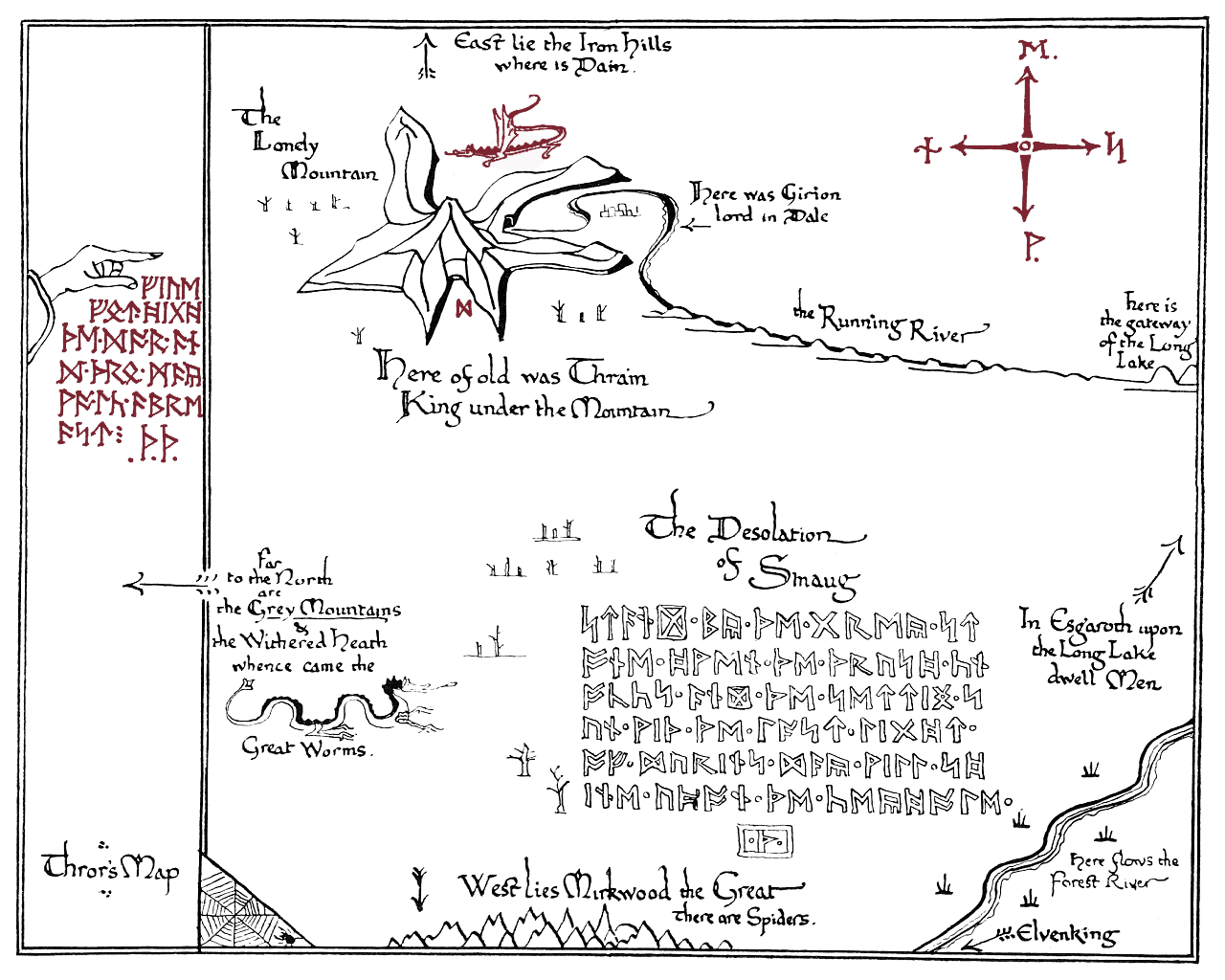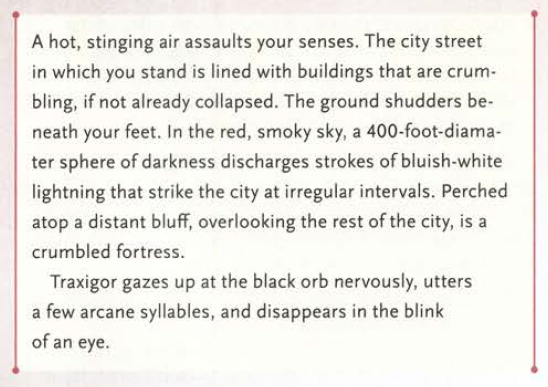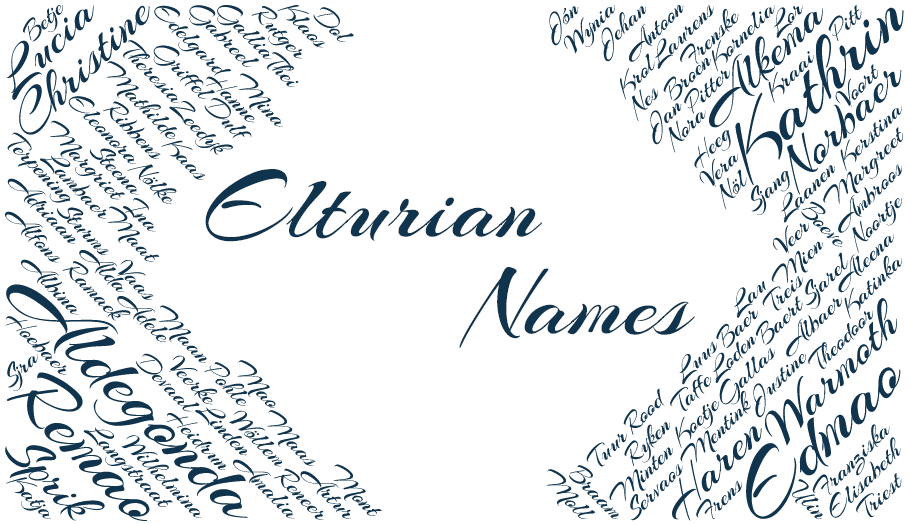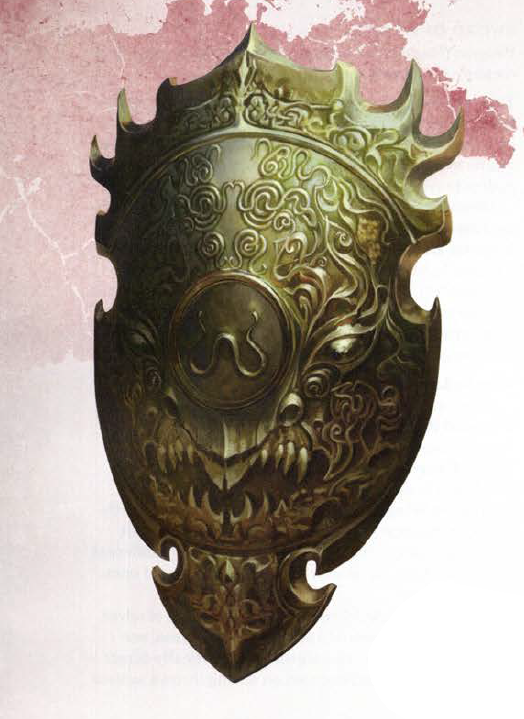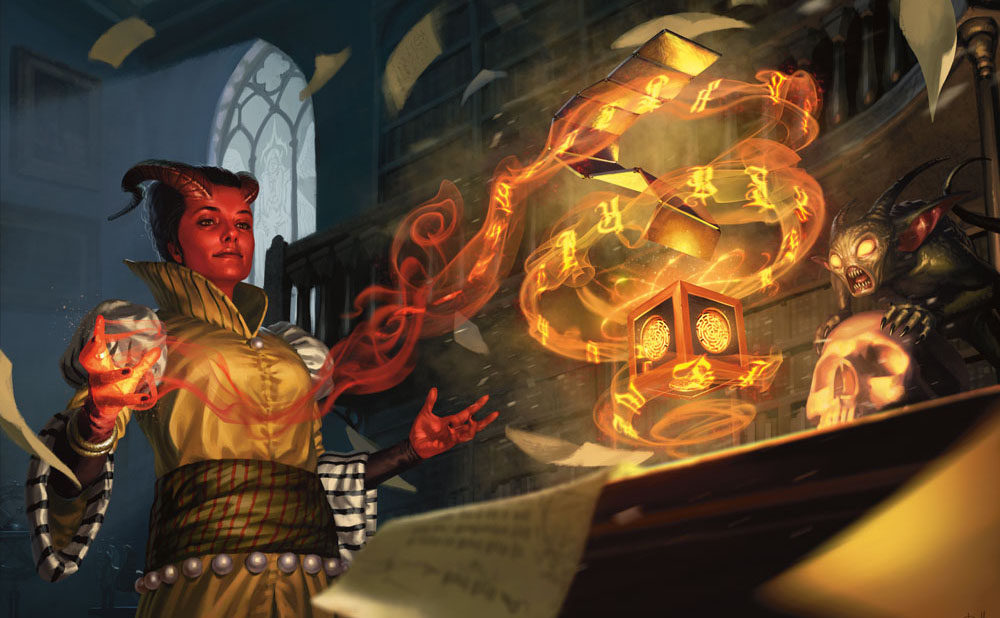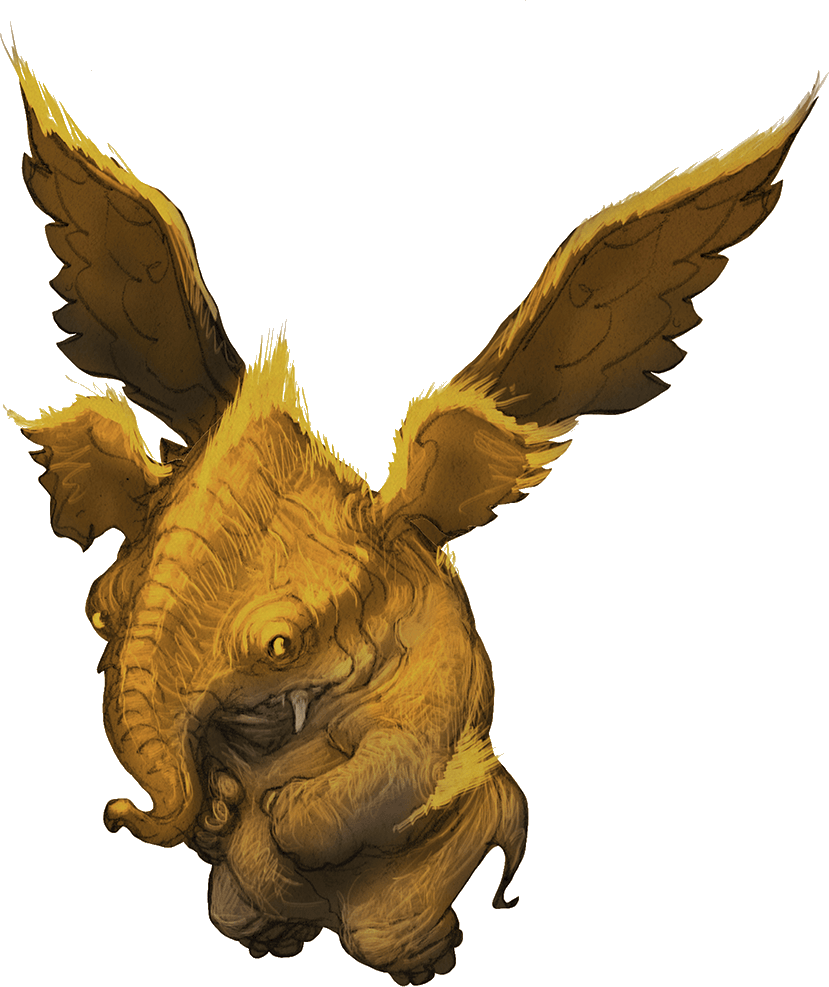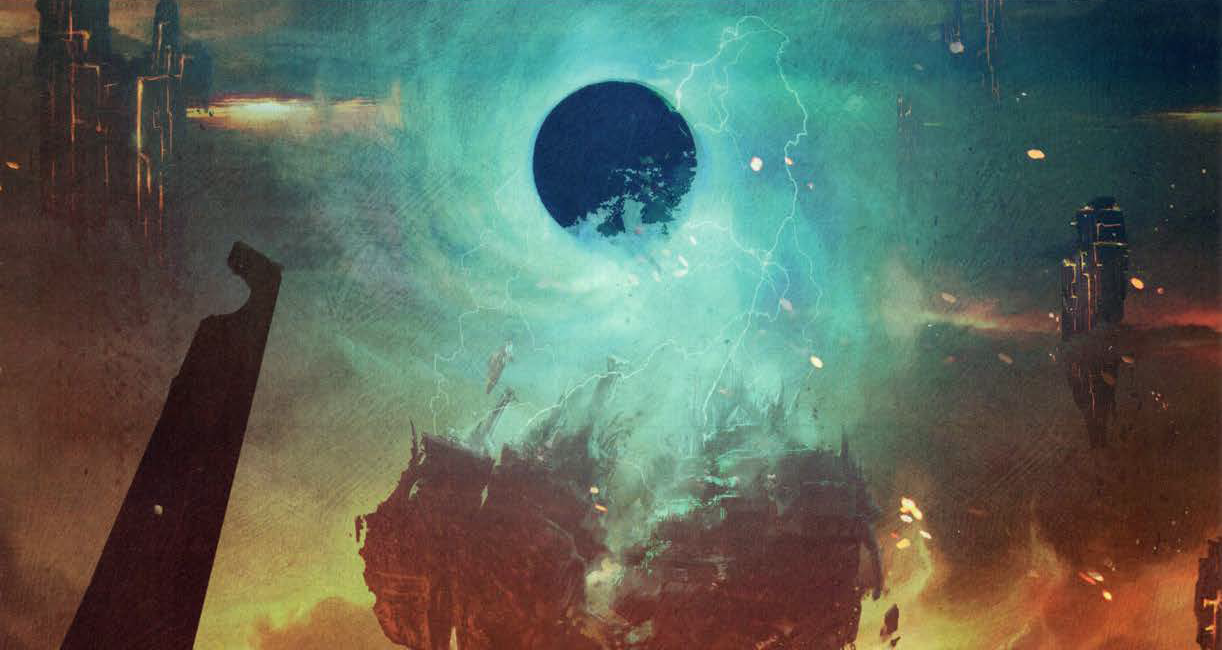
Go to Table of Contents
Before the PCs arrive in Elturel, we need to talk about the current state of the city, because there are some basic issues that should be addressed.
First, the city is broadly described as if the Fall of Elturel just happened. There’s one reference to a family’s supplies running out (although not how many supplies they had to start with), but other than that pretty much everything in Chapter 2 is described as if the city were still in the earliest hours and confusion of the crisis.
Except this isn’t true: It would take at least ten days for the first refugees to reach Baldur’s Gate. Even if we assume the gates were immediately closed (although that’s an iffy reading of the text), the PCs still need at least a couple of days to investigate the murders. Then it’s four days to Candlekeep. So Elturel was actually taken at least 15-20 days ago by the time the PCs show up.
On the flip side, when the PCs are done in Elturel they’re going to head out on a quest to find the Sword of Zariel. As they leave, they must suspect that they will be gone for at least days. In point of fact, it’s likely that they will be gone for weeks before they can return to save the city.
The problem is that nothing about the current situation in Elturel makes it seem plausible that there will be anything worth saving by the time the PCs get back: Demons and devils are freely roaming the streets of the city, more or less systematically slaughtering people in their homes. There’s no organized resistance and no reasonable expectation that there’s going to be one. (Ravengard supposedly “organized a defense,” but has actually just spent 2+ weeks cowering in a basement and now his meager retinue of guards has been wiped out.)
This creates a situation where the PCs need to do X in order to save the city, but have no reasonable expectation that they can actually achieve X in time to save the city. The result is not a sense of urgency, but rather a conclusion that the plan can’t work. A plan that doesn’t work, of course, will be discarded, and the PCs will end up looking for a different solution: They might stay in Elturel and try to spearhead a defense themselves. Or they might abandon the entire idea of “saving the city” and look for other alternatives, like simply escaping themselves or organizing some kind of inter-planar evacuation for as many people as possible.
Of course, you could use an NPC to say, “I promise you, as the Dungeon Master, that you’re supposed to go on this quest and I guarantee that the city will not fall and a bunch of people won’t be slaughtered in a devilish genocide while you’re gone.”
The result, however, still won’t be urgency: The players will probably go and do the thing, but Elturel will lose any sense of reality for them and the “crisis” will lose all meaning. Like a video game where the world remains frozen in a state of status quo until you hit the button labeled Next Plot Point, the world will be reduced to two-dimensional cardboard cut-outs.
So what we need are two things:
- A clear understanding of what’s been happening in the city in the fortnight since it was sent to Hell, and what the current situation is when the PCs arrive.
- Some form of status quo in which the city seems secure enough that the PCs can leave, do their quest, and have a reasonable expectation that there’ll still be a city to save when they come back.
However, we don’t want the status quo to feel too safe. The city is in Hell and being dragged to its destruction in the River Styx. There’s a very fine line that needs to be walked here between the PCs feeling that Elturel will still exist if they can hurry up and save it and the PCs feeling like there’s nothing to worry about.
For similar reasons, although we can easily imagine a scenario in which the status quo has already been firmly established by the time the PCs arrive (most likely some variant of Ravengard actually securing the city), that’s probably also the wrong direction to go: The PCs are walking into Hell. We want them to feel that; not enjoy some weird Pax Elturian.
WHERE ARE THE LEADERS? In the adventure as written, the highest surviving authority of Elturgard is supposedly a lone acolyte named Pherria Jynks. Descent Into Avernus tries to explain this with a meteor that fell out of the sky and destroyed most of the High Hall.
But that still doesn’t make a lot of sense, does it? Even in a Designated Survivor situation where the “entire” government is in a meeting that explodes, you still have the vast majority of the military and civilian infrastructure and chain of command intact. You don’t end up in a situation where the entire government is just one DMV clerk.
WHERE ARE THE DEVILS? Descent Into Avernus tries to explain why the legions of Avernus haven’t overrun the city already with the Battle of Elturel. At the very moment that Elturel popped in, a huge army of demons crossed the Styx and attacked the assembled legions. A huge battle broke out.
The battle has continued, without change, for 15-20 days.
It will continue, without any change, for the next several weeks.
Despite this, the battle is incredibly isolated: No reinforcements are arriving. No one in the area even seems to be aware of it.
In short, the Battle of Elturel is a valiant effort to explain why Elturel remains largely unmolested, but it actually contributes greatly to the sense that Elturel can’t possibly survive long enough for the PCs to save it. Yes, we know that the battle is just a permanent, unchanging video game instance with the same actions playing on an endless loop, but if you accept the situation at face value, then it would seem as if the battle would certainly conclude shortly and the city would be overrun.
THE PHYSICAL & METAPHYSICAL
The Companion now hangs low and large in the sky, basically on a level with the High Hall. It emits a strange, purplish-black light that mixes kaleidoscopically with the reddish light of Hell itself. Thunder from the lightning crackling across its surface intermittently cascades across the city.
Elturel is floating in the sky above the Avernian plains, connected to the Dock of Fallen Cities by huge chains.
THE CHAINS: The chains obviously have a physical reality, but they are also a metaphysical construct. They both represent the corruption of the city and are operant upon it. They are not just physically dragging Elturel down into Hell, they are also dragging down the souls of everyone in the city.
This is possible due to the influence of the Companion and the Writ of the Pact. To be clear, this process doesn’t mind control the people in the city or somehow make them evil. It’s subtler than that; a contamination of the city’s collective souls with something akin to original sin. Conversely the city remains afloat because the souls of the city are fighting against this taint.
As described in “The Metaphysics of Elturel’s Fall” (Part 4B), the final stroke comes when the city completes its descent into both sin and the Styx: The population drowns not only in the waters of the river, but in their own sin at the very moment that their minds are wiped clean and the Pact completes.
DOCK OF FALLEN CITIES: Elturel is not the first city to suffer this fate. It is actually tethered to an ancient facility known as the Dock of Fallen Cities. The chains are connected to huge pillars that rise out of the Avernian plains. Between and around these pillars are the overlapping layers of countless cities which have been pulled down and drowned in the Styx. The river still floods their broken and forgotten streets.
These cities are most likely drawn from across the multiverse, so when the PCs pick their way through the ruins you should feel empowered to get romantic with your descriptions of the melancholic, cyclopean ruins. They are most likely haunted by strange will o’ wisps, which are perhaps related to the Many Colours Out of Space that are here the spiritual detritus left behind by a dozen dead civilizations.
WHERE ARE THE DEVILS? The Dock of Fallen Cities here takes the place of the Battle of Elturel: There was no demonic invasion. There is no endless, looping confrontation.
So why hasn’t Zariel sent her legions into Elturel to pacify the city?
Largely because she doesn’t need to. With a few key exceptions (described below), killing the population before they can drown in the Styx is actually contradictory to her goals. There are some devils stationed around the pillars to make sure no one messes with the chains (not that there’s actually anything the PCs or anyone else in Elturel can do to the chains without a lot of help, see Part 6), but they honestly don’t care if a few people manage to “escape” the city.
HOSTILES
Even though Zariel isn’t motivated to stage an invasion of a city she’s already conquered, that doesn’t mean that the city is in any way safe.
ZARIEL CULTISTS: Zarielites from across Faerun had learned what was coming and made the city a sort of pilgrimage site in the final days before its Fall. (They knew it was going to Hell and they hitched a ride.)
Once they arrived in Hell, groups of these jubilant cultists emerged onto the streets in a millenarian orgy of sin and destruction. Many have indiscriminately pillaged and burned. Others have set up little gangland fiefs of oppression and misery. Regardless, they all know the party ends when the city hits the Styx, and they’re mostly okay with that (believing that in the moment of the Pact’s completion they will be exalted as powerful devils).
In addition, while many members of the Cult of the Companion (see Part 3B and Part 4B) fled the city before its Fall (much like Thavius Kreeg), others remained. Many of those became Hell Knights (see below), but others remain as a sort of fifth column. (Adding such a fifth columnist to the refugees in the High Hall is an obvious choice.)
Devil cultists have the shadows of devils here. Those in the former group tend to delight in this; those in the fifth column will obviously take efforts to hide it.
HELL KNIGHTS: Before the Fall, the High Knights were the upper echelons of the Elturian government. The term originally applied to those who could lead (or had led) a grand expedition of the Hellriders, including the High Rider and the High Watcher of Helm’s Shieldhall. The use of the title formalized and then expanded over time until essentially every senior member of the government was a High Knight (along with a fair number of lower positions as well).
By the time Thavius Kreeg became High Observer, many of the High Knights were already Zarielites, and Kreeg made sure that most of the remaining High Knights were also replaced by cultists. By the time of the Fall, the High Knights were largely synonymous with the inner circle of the cult. These cultists had sworn special oaths above and beyond the Creed Resolute, and as Elturel was pulled into Hell they immediately transformed into devils, becoming Hell Knights.
These Hell Knights had two immediate goals: First, they began slaughtering the other knights under their command. As noted previously, any Elturian knights who had sworn the Creed Resolute and were killed after Elturel was sent to Hell had their souls immediately claimed by the Pact. Here in Hell itself, this meant that any knight killed was immediately transformed into another Hell Knight.
Second, as their ranks swelled with devils, the Hell Knights targeted wizards, clerics, and other high-level or important characters who might pose a threat. Most of their targets were eliminated within the first few hours of chaos, and the Hell Knights continue hunting for those who escaped the initial purge.
(You can use any devil stats for a Hell Knight, with specific recommendations being given in Part 7G. They generally still wear the armor of their former orders.)
DEVIL RAIDERS & DEMON INVADERS: Although Zariel is not sending in her legions, Elturel is not free from devils. Small groups of devil raiders from the Avernian plains have snuck into the city to loot and rend what they can before the city’s final destruction. (Would you sell your soul to escape Hell? They can offer that, too.)
In addition, a lieutenant of Yeenoghu named Liashandra has led a platoon of demonic troops into the floating city. They’re perhaps the most immediately dangerous to the common people of the city, reveling in wanton destruction as is their demonic wont. However, Liashandra’s primary mission is to sabotage the Fall of Elturel if she can and prevent Zariel from recruiting the entire city into the ranks of her legions.
This means that all of these hostile factions (Zarielites, devil raiders, and the demonic incursion) are as likely to be fighting each other as anyone else. Liashandra might also be an unexpected ally in saving the city.
THE VAMPIRE LORD: When the Companion first appeared in the sky above Elturel, the vampire lord High Rider Ikaia was not destroyed. He fled into the vast cavernworks beneath the city and lurked there for decades. Now the Companion is gone and the High Rider has emerged.
He does not, however, command a slavering horde of vampires. He and a select few “sons and daughters” are actually a bastion in the northeast of the city: Elturgard maintained vast storehouses in the caverns beneath the city, with supplies that could support hundreds of thousands of people for months if the surrounding farmlands had to be evacuated into the city and a heavy siege were laid. Ikaia has secured some of these storehouses that were scooped up along with the rest of the city and is now distributing them to people in need (see Part 5C).
A STABLE ELTUREL
Last but not least, what needs to happen for the situation in Elturel to feel stable enough that the PCs will feel comfortable leaving?
Well, to some extent I think we’ve tweaked things enough so that the city still feels like a warzone without feeling like such a genocidal horror that the PCs would reasonably expect everyone to be dead within a week. So it’s possible that you’ll just glide past this point without the PCs thinking about it.
Failing that, there’s also the clear cosmological deadline of the city being drawn down into the Styx. Yes, you could help here, but it’s all meaningless unless someone can get the sword and save the day!
But it’s quite possible that the players will still feel it necessary to help stabilize the situation in Elturel. Or maybe you’re just interested in exploring that idea.
Unless you want to radically expand this section of the campaign, what you’ll want is a Grand Gesture That Turns the Tide; i.e., one big thing that the PCs can do (or help do) that can be framed as essentially putting things on the right track. Possibilities might include:
- Joining the east and west sides of the city. This might be leading attacks on the bridges, clearing them of demon infestation, and helping Ravengard set up garrisons there.
- Forging alliances between the surviving enclaves. This would send the PCs around the city essentially as ambassadors.
- Securing the supplies necessary for survival. Ravengard, for example, might know that somebody on the east side of the city has a cache of supplies. When the PCs investigate, they find High Rider Ikaia. They might negotiate with him for access to the supplies; or they might track Ikaia’s people back to the cache they’ve secured and then clear them out.
- Some sort of mass combat (most likely with Ravengard and his men). That might be leading a siege on Helm’s Shieldhall and shattering the stronghold of the Hell Knights. Or returning to the cemetery and cleaning it out.
I’d recommend following the players’ lead here: They’re unlikely to just say, “We need to secure the city… but how?!” Rather, they’ll have some specific problem that they’re looking to solve (the population is starving, Ravengard doesn’t have enough soldiers, etc.). They might even have a plan. You just need to make sure to give them the opportunity to carry out that plan and then frame the outcome as the city turning a corner in its struggle for survival. “This has made all the difference. Now go get that sword!” says Ravengard (or whoever).
If you DO want to radically expand this section of the campaign, then you’ll want to provide a structure for the PCs’ efforts. This will most likely consist of specific needs that the city has and flexible options for how those needs can be achieved. Off the top of my head:
- Food & Water. Seizing or gaining access to Ikaia’s storehouse. Finding alternative storehouses. A magical fountain. Organizing rationing.
- Security. Eliminating specific threats. Forming alliances. Restoring one of the demonseals which once protected the major citadels of the city by scavenging components from each.
- Shelter. Forming neighborhood patrols. Securing citadels which can house refugees in safety away from the demon-infested streets.
Once again, be flexible in responding to and empowering ideas the PCs come up with to fulfill these needs. I would go so far as to track these needs with specific gauges; i.e., put hard numbers on this and let the PCs’ schemes score points towards filling those gauges. (And, conversely, allow enemy factions to damage the gauges.)
THE RETURN TO ELTUREL
Later in the campaign, the PCs will return to Elturel. What do they find when they come back? How has the situation developed?
To a large degree, the answer to this should be extremely idiosyncratic and heavily based on what the PCs did: The version of Elturel where the city ended up divided between Ravengard in the west and Ikaia in the east is very different than one where the PCs managed to form a Council of the Resistance which included Liashandra as a prominent member.
If we’re talking about a baseline situation where the PCs did very little to shift the status quo in Elturel, then here’s what I’d suggest:
- High Rider Ikaia has secured the eastern side of the town. Citizens have volunteered to become vampires in order to have the strength to defend themselves and their fellow citizens, and these Vampire Riders run regular patrols and control the bridges.
- Things are much worse in the west. The Hell Knights have mustered their forces and laid siege to Ravengard in the High Hall.
Go to Part 5B-A: Arrival in Hellturel


